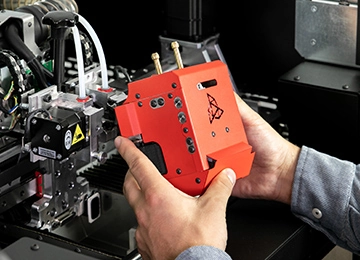Manual
Firmware
Software
Useful terms
FAQ
Guarantee terms and conditions
3DGENCE SLICER
-
Nylon
A group of polyamide materials developed by DuPont company. Currently, these are used also for producing resistant filaments for 3D prints. Its main advantage includes its high mechanical and chemical strength, possibility of further processing and coloring with textile dyes. Prints feature also some flexibility and resistance to rupture.
-
Nozzle
A head component coming into direct contact with the print. The nozzle heated to temperature specific for a material makes it flow and forms a thread of plastic with a rated nozzle diameter. The 3DGence ONE printer as standard is equipped with a 0.4 mm nozzle. The nozzle outlet diameter affects the available resolutions, print speed and accuracy.
-
Knurl
This is an extruder part, driven by a stepper motor. It makes it possible to accurately feed the plastic wire to the printer nozzle thanks to its concave, “toothed/knurled” recess that “bites” into the plastic wire. An element that strictly cooperates with the knurl is the clamp providing a correct contact between the knurl and the filament.
-
HIPS
High-Impact Polystyrene – a styrene polymer. It is used mainly in 3D printing as a material for printing support structures for ABS plastic. It is soluble in d-limonene. It features a high impact resistance and a low flexibility.
-
G-code
This is a normalized programming language adjusted to control CAM machines. In simple words, the G-code string includes machine instructions – in what direction, how fast and along which axis to move. The code for printers is generated by slicing software (slicers). It stores all the data on subassembly temperatures and the revs of motors in a precision sequence that results in moving the hotend and defines the extruder behavior. The code commands are sent line by line to the printer controller processor during the printing process. The processor interprets the code based on its software and sends specific signals to particular components.
-
Firmware
It is responsible for the interpretation of the commands contained in the machine code (G – code). The effect of its work are the basic signals for heaters, motors and fans. It is responsible for the interpretation of accelerations, temperature correction tables and many other factors. Well-tuned firmware is an important element of machine calibration, because it is responsible for the regulation of breaks, accelerations and other key parameters for good performance of the device.
-
Filament
Popular description for material used to print in fused deposition modeling (FFF) technology. The filament is a thermoplastic wire (PLA, ABS, PVA, HIPS, PC, Nylon or other) generated with specific tolerances The filament is wound on a spool. The relevant parameters when selecting a filament include: dimensional tolerance and the method for protection against moisture (optimally the filament should be vacuum packed with a moisture absorber.) A high diameter of the spool hub provides an opportunity to use its entire length – an excessive bending of the filament (e.g. on a small spool hub) can cause problems with its application. The filament after opening the package should be stored in a dark, dry place with a moisture absorber.
-
Extruder
A part of the 3D printer working in the FFF technology. It is designed to feed the filament at a strictly defined rate, and consequently – quantity. The 3DGence ONE printer is fitted with a Direct Drive type extruder. It means that extruder motors are located beyond the moving printer parts, leading material to the head via the PTFE tubing. It makes the design lighter and has a positive impact on the print quality.
-
Endstop
An optoelectronic switch that limits a 3D printer movement beyond the maximum range. The device is fitted with 3 optical endstops – one for each axis. The optical endstop does not require any physical contact with the corresponding interrupter, which provides its long life, however one should notice that it is sensitive to the sources of bright light which may result in triggering its false operation.
-
Brim
One of the methods of improving print adhesion to the bed. It consists in increasing the adhesion surface to the bed by generating additional, external brims of the solid at the level of the first layer of the print. The more brim lines will be added, the larger will be the adhesion surface. Typically, from 5 to 20 brim lines are used. The brim should be used, in case of problems with detaching prints from the bed.
Lorem ipsum
Lorem ipsum

